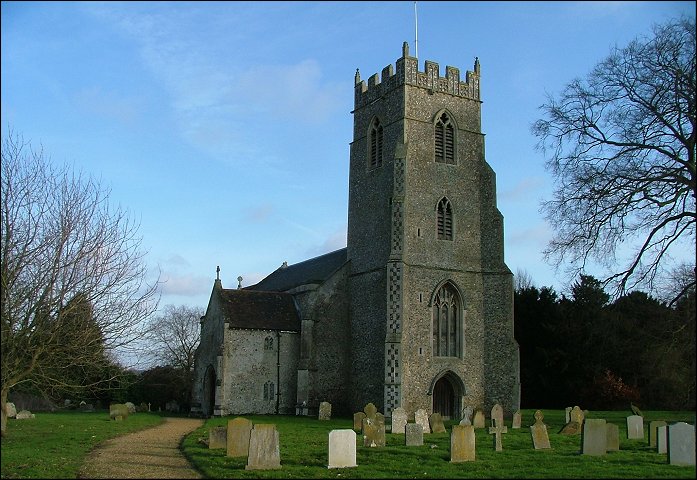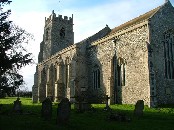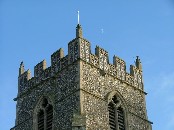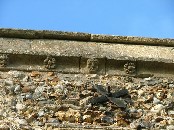| |
|
St Mary,
North Tuddenham
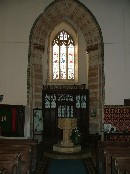 |
|
This
mighty building sits a few hundred metres from
the roar of the A47, but it has a presence about
it that soon makes you forget the noise of
traffic. There is no village, no houses at all
nearby, just this huge fortress sitting in the
fields. Pretty much everything you see post-dates
the Black Death. The tower is the earliest part,
from just before 1400, and then a sequence of
bequests leads to the nave, chancel and internal
furnishings that are finished by the early 16th
century. This is the English Church at the height
of its late medieval glory. Because
there is no clerestory, no aisles, and everything
is to scale, it is difficult to really get an
impression from the photographs above of quite
how vast St Mary is. Look at the top picture; I
am six feet tall, and when I stood beside the
porch, my head didn't come quite up to the top of
the lower windows. English churches naturally
have an air of permanence, but this building is
positively bullish about its intention to sit
here for all eternity, and longer if possible.
|
But East
Anglia has loads of big churches, so what makes North
Tuddenham special? Well, there's nowhere quite like it.
We expected to have to get a key, but as we approached
the building we could hear sad organ music playing. I
tried the door, and it was open. We stepped inside, into
a temperature a good five degrees colder than the winter
air outside.
It was
like entering a cathedral. As our breath clouded the air,
I looked eastward towards the vast mouth of the chancel
arch into what is nothing less than a Victorian citadel.
| The
walls, to a height of six feet or more, are
covered in vivid patterned tiles. Beyond them,
rising to the high roof, is elaborate
stencilling. This happened to many churches,
especially big ones, but by the 1960s and 1970s,
when enthusiasm for Victorian styles was at its
nadir, they were being removed and destroyed in
vast quantities. Even here, they were painted
over, but a change of heart has revealed them to
the light of day again. High above, huge pastel
roundels depict angels and Saints. This is seen
at its most complete in the chancel, which could
so easily be some 19th century Anglo-catholic
temple in London, Buenos Aires or Calcutta. In the
nave, the huge windows are filled with Ward &
Hughes glass, but the upper lights have a
wonderful collection of glass from the 14th and
15th centuries.
|
|
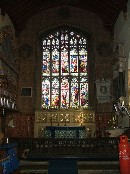 |
Two
consecutive Rectors left their indelible mark on St Mary.
They were Robert Barry and Benjamin Armstrong, who
between them shepherded the parish from 1851 to 1924. As
we know, the vast majority of parish churches were
restored to their medieval configuration by the
Victorians after centuries as preaching houses, but few
churches retain quite so much evidence of this as St
Mary.
 |
|
The
story goes that Barry found the medieval glass in
a builder's yard in nearby Dereham in the early
1880s. There are ideas about where it came from;
half a century later, surviving members of the
Armstrong family recalled Barry mentioning
Billingford, near North Elmham, or perhaps
Elsing. Neither is likely, and perhaps we will
never know. There are parts of several
sequences, most notably the life and martyrdoms
of St Margaret and St George, the Seven
Sacraments, the Apostles with Creed scrolls, and,
most unusually, incidents in the teaching life of
Christ. The best is probably in the west window,
but there are also figures in the upper lights of
the north aisle and in some of the south aisle.
Fragments of other pieces are in the porch
windows, and what couldn't be fitted in here was
given to nearby Welbourne, where it can still be
seen in the porch windows there.
|
In the
west window are two panels depicting incidents early in
the St Margaret story. In the first she sits in a field
and spins, and in the second we see her for the first
time in her suitor's palace. St Margaret was a hugely
important Saint in medieval East Anglia. A large
proportion of the churches in England dedicated to her
are in Norfolk and Suffolk. Part of another sequence of
her life and martyrdom survives at Combs in Suffolk, and
there is a record of another at Heydon, now lost. The
third panel in the lower west window depicts two
incidents in the St George story, his donning of his
armour and his attacking the dragon.
Images
from the martyrdoms, as well as from the other sequences,
can be seen below. Hover for a caption, and click on them
to see them enlarged.
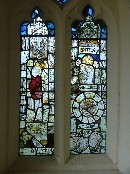 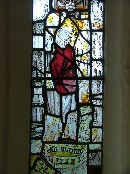 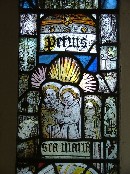 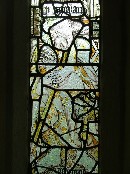 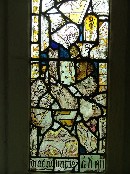
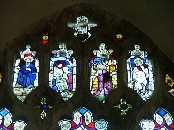 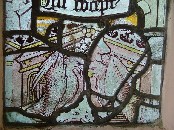 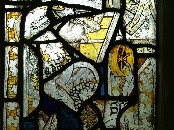
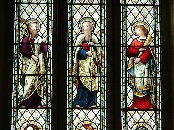
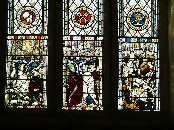 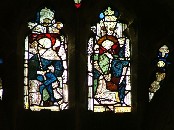 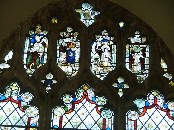 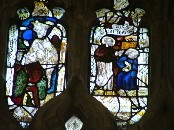
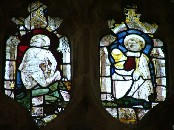 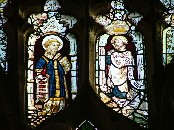 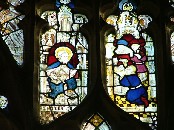
As I
photographed the glass, Peter chatted to the nice man who
had been playing the organ. The temperature inside this
vast barn was not much more than freezing, and so he had
huddled by one of the heaters in the chancel to practice
the hymns for Sunday. I wondered how on earth they kept
this place warm in winter, but as the man pointed out,
their congregation was only six or seven, and so they
didn't use the nave anymore.
| Even
in the chancel, they must rattle around. This
church would seat seven or eight hundred people
quite comfortably, and it is extraordinary to
think that barely a hundredth of this number use
it regularly now. The man said that they would
keep the church going as long as they could, but
of course it must never be lost to us, because it
is a national treasure. And it
isn't only the glass. The screen, which probably
did come from here, retains panel paintings from
the first decades of the 16th century, shortly
before the Reformation.
|
|
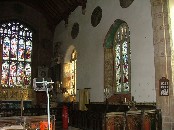 |
There are
twelve panels, but only the middle eight have figures.
They are St Agnes, St Gregory, St Dorothy and St Jeron on
the north side, and St Catherine, St Sebastian, St
Etheldreda and St Roche on the south side. St Agnes has a
dagger pointed at her neck and her lamb at her foot. St
Dorothy has flowers and fruit, while St Jeron has a
falcon on his arm. St Catherine holds her sword and
wheel, St Sebastian an arrow and St Roche points at the
plague sores on his leg as at Stalham.
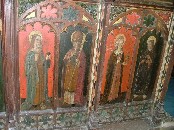 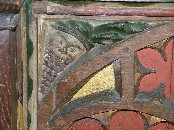 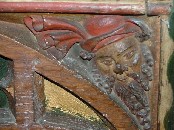 
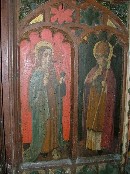
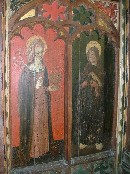
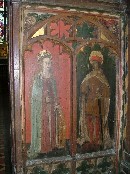 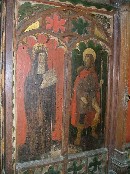
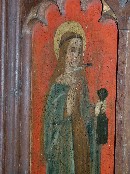 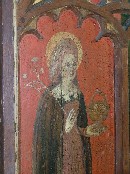 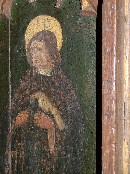 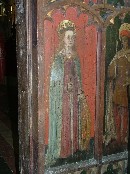
There are
more panels from a dado built into the tower arch screen.
Mortlock records that these were bought by Barry from 'a
lumber shop'. They depict two of the four evangelists,
Matthew and Mark, and two of the four Latin doctors,
Gregory and Augustine. I wonder where the other four are?
As the
Church of England slowly retreats into managed decline,
buildings like this are a huge burden. What is the future
for it?
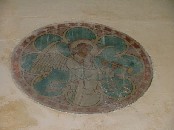 |
|
St
Mary is an important historical document, but it
is more than that. It is a monument to taste, the
fashionable passions of the late 19th and early
20th centuries. Many of the elements that make it
up are medieval,certainly, but what you see here
is a coherent testimony to a late Victorian
vision of what the Middle Ages had been like, to
a time in the life of the Church of England that
has now slipped just out of reach. There is
grandeur, to be sure; but it is the triumph of a
lost age. Even if you were not interested
particularly in the 15th and early 16th
centuries, this would be a place to come, if only
to sense the ghosts of militant Victorian
Anglo-catholicism.
|
| But
there is even more. For, as I stood there, I felt
a quiet sadness come dropping slowly through the
icy air. This is a tremendous place, and it is
still loved; but the church that Barry and
Armstrong created is dying, finally reaching the
end of its liturgical and artistic life. It has
been left out on the end of an event, having
survived it; but now hardly anyone remains to
celebrate it. There will never be an
another Anglo-catholic revival in the Church of
England, and soon only buildings like this will
remind us of it, precious evidence of that
extraordinary time.
|
|
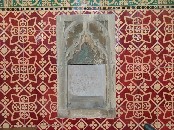 |
Simon Knott, February 2006
|
|
|

